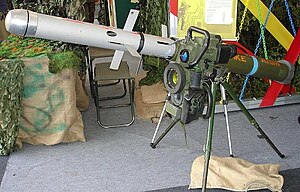| Spike | |
|---|---|
 Spike ATGM Command & launcher unit (CLU) with mock-up Spike LR missile mounted on a tripod at Singapore Army Open House 2007 | |
| Type | Anti-tank guided missile |
| Place of origin | Israel |
| Service history | |
| In service |
|
| Used by | See Operators (41 countries ordered it[1]) |
| Wars | |
| Production history | |
| Designer | Rafael Advanced Defense Systems |
| Designed | Late 1970s (Spike NLOS) |
| Manufacturer | Rafael Advanced Defense Systems & EUROSPIKE GmbH
|
| Unit cost | $249,966 (US Army Spike NLOS, 2022), $140,000 (German Spike LR, 2017)[2] |
| Produced |
|
| No. built | 40,000 (2023)[3] (7,000 fired) |
| Variants | See variants |
| Specifications | |
| Mass | Spike ER from helicopter:
Spike MR/LR from tripod:[4]
Spike SR:
|
| Length |
|
| Diameter |
|
| Rate of fire | Ready to launch in 30 seconds, 15 seconds to reload |
| Effective firing range |
|
| Sights | 10× optical sight |
| Warhead | HEAT Tandem-charge |
Detonation mechanism | Piezoelectric trigger |
| Engine | Solid-propellant rocket |
Guidance system | Target acquisition (day and night capacity):
Missile guidance:
|
Spike (Hebrew: ספייק) is an Israeli fire-and-forget anti-tank guided missile and anti-personnel missile with a tandem-charge high-explosive anti-tank (HEAT) warhead. As of 2024[update], it is in its sixth generation.[5] It was developed and designed by the Israeli company Rafael Advanced Defense Systems. It is available in man-portable, vehicle-launched, helicopter-launched and maritime variants.
The missile can engage and destroy targets within the line-of-sight of the launcher ("fire-and-forget"), and some variants can make a top attack through a "fire, observe and update" method (essentially lock-on after launch);[5] the operator tracking the target, or switching to another target, optically through the trailing fiber-optic wire (or RF link in the case of the vehicle-mounted, long-range NLOS variant) while the missile is climbing to altitude after launch. This is similar to the lofted trajectory flight profile of the US FGM-148 Javelin.
- ^ "Rafael wins naval maintenance and anti-tank missile deals". GLOBES. 13 August 2023. Retrieved 14 August 2023.
- ^ "NT Spike" (PDF). World Missiles & UAVs Briefing. Fairfax, Virginia: Teal Group. March 2023. Retrieved 17 April 2024.
- ^ "Rafael wins naval maintenance and anti-tank missile deals". GLOBES. 13 August 2023. Retrieved 14 August 2023.
- ^ "A multitude of launchers – for a multitude of use". EuroSpike GmbH. Archived from the original on 10 July 2011. Retrieved 29 June 2010.
- ^ a b https://www.rafael.co.il/system/spike-nlos/ [bare URL]